When the Mets signed Francisco Lindor to a mammoth 10-year/$341 million contract, it made him, by quite some margin, the highest-paid shortstop in baseball. Lindor was handed the keys to the franchise for a Mets team that was increasingly getting more exciting. However, in his first season in Queens, Lindor hit just .230, as the Mets would limp their way across the finish line with just 77 wins to show for their efforts. The 2021 Mets were a tremendous disappointment for a team that had so much hype coming into the season, and who even ended up buying at the trade deadline, acquiring Javier Báez from the Cubs, only for the wheels to fall off as the summer drew to a close.
Lindor, coming off a weak 2020 campaign, had just posted his second consecutive season with an OPS of .750 or lower. 2021 was his weakest offensive season yet, with an OPS+ of 100 – exactly average. Suddenly, the narrative around Lindor had shifted radically. Did the Mets really spend a third of a billion dollars on a league-average hitter!? This sudden shift is exemplified in MLB.com’s annual top 100 player ranking, of which Lindor had enjoyed plenty of praise in previous years, but where did Lindor rank after such a disappointing year?
Yikes
Lindor was an industry-consensus top 20 player and had just signed an enormous contract for a big-market club looking to swing for the fences. Yet in his first season, his stock tanked. A FIFTY-THREE spot drop in the rankings for someone who was signed to be a superstar. Lindor was ranked behind players like Jesse Winker, Javier Báez, Salvador Perez, and Giancarlo Stanton. This was starting to look like a blunder from the Mets, a big ol’ swing and a miss – then something interesting happened. Over the last two seasons, Francisco Lindor has not only bounced back from his 2021 struggles but has firmly re-established himself as one of the game’s premier stars. Make no mistake, Francisco Lindor is one of the best players in baseball, and we aren’t talking about him enough.
Respect
Who are the best shortstops in baseball? This is a question I asked the Pitcher List staff, asking them to give their personal top 5 shortstops in baseball. The current generation of shortstops is as strong as we have ever seen, and this question garnered some interesting responses, including where my coworkers ranked Francisco Lindor:
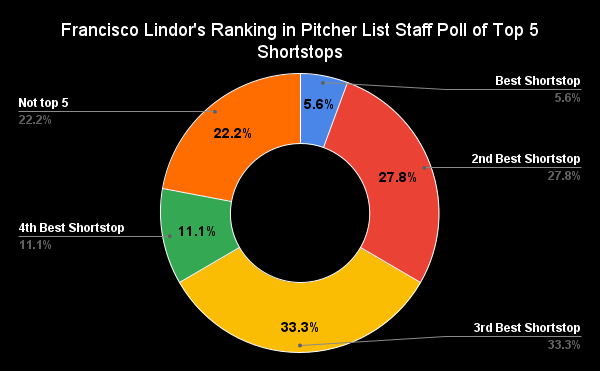
Well, that’s interesting. The majority believe Lindor to be in the upper echelon of talent at short, but take a look at how many believe Lindor to not be in the top five at all! This isn’t necessarily indicative of Lindor’s reputation, but it’s reasonable to infer that Lindor is still fighting off the scathing reviews he faced coming out of his 2021 campaign. Equally noteworthy is Lindor has not made an all-star game since 2019. The All-Star Game, of course, is primarily based on fan-voting. Yet Lindor, playing for a big market club with a massive contract, has been unable to get the support necessary to bring him to an ASG. To me, it’s clear, Lindor is not getting the respect he deserves from baseball fans.
Now, the narrative is shifting back in Lindor’s favor. MLB Network just placed Lindor second on their list of top shortstops in baseball, and last year they corrected their mistake and put Lindor 21st on their annual top 100 players list, and he’s likely to move up yet again. Still, it’s evident that we as baseball fans are not respecting Francisco Lindor enough, and how he hasn’t just been good but has been one of the best players in baseball for the better part of a decade. Just how good has he been?
Generational?
Mike Trout and Mookie Betts. Undoubtedly the two best position players of this generation, both should easily be inner-circle hall of famers when it’s all said and done, but who’s third? There are several different players to choose from, from the eerily similar careers of Paul Goldschmidt and Freddie Freeman to the hot corner phenoms Nolan Arenado, Manny Machado, and José Ramirez. You probably know where this is going, but where do you think Lindor ranks in fWAR since entering the league in 2015?
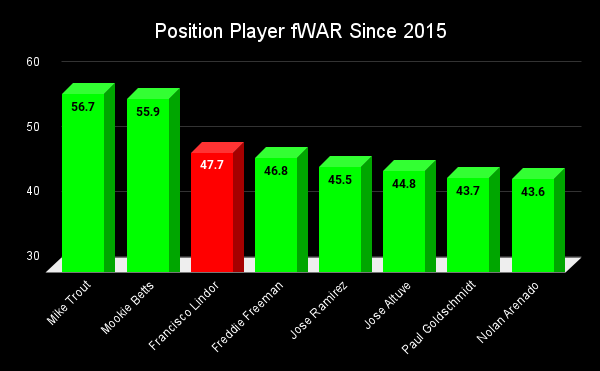
Third! He ranks third! It’s by the narrowest of margins, but it’s impossible to deny that since entering the league Lindor has been one of the very finest players in all of baseball. This article will explore all facets of Lindor’s game that make him such a valuable player, but let’s first compare Lindor to his fellow shortstops, to see how he compares to his contemporaries:
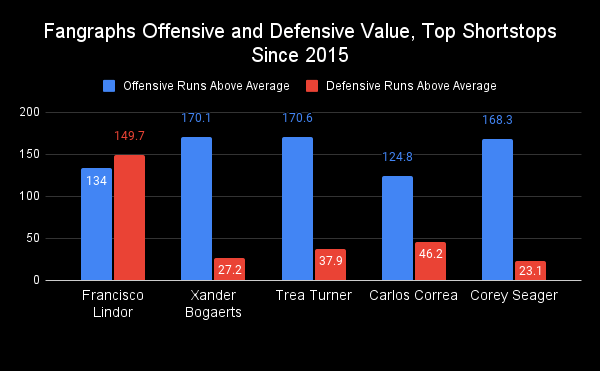 Even among this incredible generation of shortstops, Lindor clearly stands out in just how valuable he’s been. Lindor has a unique blend of offensive and defensive talent that has made him among the most productive players in the league since being called up in 2015 at the young age of 21. This is the player that 22.2% of Pitcher List staff thought wasn’t a top-five shortstop? Clearly, we aren’t talking enough about just how good Lindor has been, so let’s talk about the two facets of Lindor’s game that make him so incredible: The bat and the glove.
Even among this incredible generation of shortstops, Lindor clearly stands out in just how valuable he’s been. Lindor has a unique blend of offensive and defensive talent that has made him among the most productive players in the league since being called up in 2015 at the young age of 21. This is the player that 22.2% of Pitcher List staff thought wasn’t a top-five shortstop? Clearly, we aren’t talking enough about just how good Lindor has been, so let’s talk about the two facets of Lindor’s game that make him so incredible: The bat and the glove.
The Bat
Lindor’s bat is special among shortstops because very few players can balance the defensive responsibilities of shortstop with generating significant offensive production. One glance at Lindor’s career slash line of .274/.341/.473 tells you a lot about Lindor as a hitter, but let’s go deeper:
Since 2015, Francisco Lindor has the most home runs of any shortstop in MLB.
…
Did y’all know that? That surprised me when I read that of all the incredible shortstops in baseball currently, it’s Lindor who leads the pack over players like Carlos Correa, Trevor Story, Marcus Semien, and Corey Seager. Now, to be fair, Lindor does have significantly more games played than all but Semien, but that doesn’t take away from just how proficient Lindor has been in utilizing the long ball.
When Lindor had his down year in 2021, it was a disappointment, but in retrospect, it was absurd to expect anything other than a rebound in 2022. Lindor’s BABIP was .248, good for the 6th lowest in baseball. For some hitters, like Joey Gallo or Max Muncy, a low BABIP is simply part of their game. For most hitters, however, a BABIP this low indicates that they are bound to bounce back, and bounceback Lindor did. Lindor’s 125 OPS+ in 2022 was exactly what the Mets were looking for when they signed the supposed superstar shortstop to that mammoth contract, and seemingly just like that, the two-year “slump” Lindor had ended, hitting .270 again after Lindor’s BABIP partially caused his unusually low 2021 clip of .230.
If you wanted a textbook definition for a great hitter… well you’d probably look for Freddie Freeman, but if you wanted a definition for merely a good hitter, then Francisco Lindor fits the bill nicely. Lindor’s hitter profile is fundamentally sound, a switch hitter who balances above-average power with a strong hit tool and, more recently, above-average plate discipline. His above-average-ness becomes evident looking at his year-by-year rolling xwOBA percentile rankings:
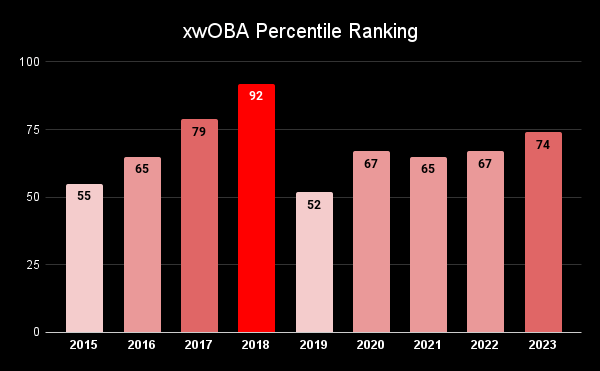
Not too much further analysis is needed here. His 2015 and 2019 seasons are rather mediocre in terms of expected results, and his 2018 seems to be an obvious outlier, but there’s no other way to interpret this chart other than to conclude Lindor is firmly an above-average hitter. That may not sound like rapturous praise, but a shortstop that can provide significant offensive production is inheritably incredibly valuable. We’ll examine just how valuable that is later, but I first want to examine Lindor’s hitter profile more. When a player reaches their age-30 season, productivity is subject to rapid and sudden decline. Recently, this has been evident in shortstops like Javier Báez, Andrelton Simmons, Trevor Story, and Tim Anderson. Those four shortstops were all solid, even very good hitters at points in their 20s, but their offensive production plummeted in or shortly after their age 30 seasons.
However, while Lindor turned 30 this past November, I don’t believe he will suffer the same fate offensively. For starters, while Lindor has never had Soto-like plate discipline, he’s never carried a K% over 20% and has increased his walk rate with the Mets to make himself a more well-rounded hitter. Those attributes help raise the floor of a player’s profile, as even in Lindor’s unfortunate 2021 season offensively, his 11.1% walk rate helped keep his OBP at a respectable .322, and OBP+ of 99. Remember, this is in a season where Lindor hit just .230, so it shouldn’t be a surprise that when his AVG bounced back the next two seasons, so too did his OBP+, returning to above-average levels. His ability to avoid strikeouts also projects well moving forward, as while several of the aforementioned shortstops have struggled when they have had their contact ability diminish, Lindor has always kept his strikeout rate in check.
Lindor has solid eyes, but he’s got better hands. His underrated power has shown itself more recently, with 2023 marking a career-best in barrel rate. In fact, 2023 might have been Lindor’s best year at the plate since 2018. Lindor also set a career-high in average exit velo and had his highest ISO since the juiced ball 2019 season, but the most intriguing development is in his batted ball distribution. In 2023 Lindor cut down on his ground ball rate, and subsequently increased his fly ball rate, resulting in career lows and highs respectively. That is an intriguing change. Combined with an increased barrel rate, the result in 2023 was more home runs, fewer ground balls (and fewer GIDP), a higher xwOBACON, and an overall stronger offensive showing. Lindor projects well going into his tenth MLB season, and there’s nothing to suggest one of the stronger offensive shortstops of this generation will lose steam anytime soon.
The Glove
This modern shortstop generation has had unprecedented offensive production, but their value is still contingent on the strength of their glove. As we’ve already established, Lindor is relatively unique in his offensive capabilities, but what if I told you that one of the best offensive shortstops of this generation is also arguably the single best defender as well?
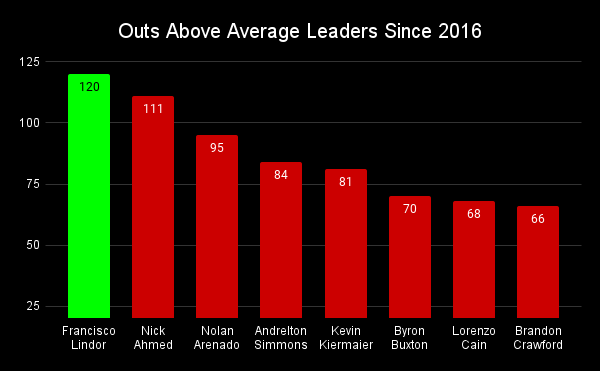
Statcast Outs Above Average fawns over Lindor, placing him atop all defenders since the stat was introduced in 2016. If that’s not convincing enough, here’s how Lindor ranks in other defensive metrics since he entered the league in 2015:
Lindor has been a shoo-in for being a gold glove finalist his whole career, and 2023 marked the first season where he didn’t put together an OAA in the double digits – yet was still 90th percentile. For a shortstop who’s just turned 30, he’s showing tremendous resilience and durability, being able to play short at such a high level for so long. There are very few players who can play at an elite level defensively and with Lindor’s consistency, yet for the better part of a decade now, Lindor has demonstrated not just above-average defense, but elite defense, no matter what stat you look at. Defense is notoriously difficult to quantify, but Lindor’s reputation as an elite defender – exemplified by his 2016 platinum glove, is very well deserved.
Other Things About Francisco Lindor We Don’t Talk About Enough
I could continue to ramble about all sorts of aspects of Lindor’s game, but instead here’s just a list of things I found fascinating while researching:
- Lindor is 11th in total stolen bases since 2015, with a career success rate of 79%. He took full advantage of the 2023 rule changes, swiping 31 bags on 35 attempts to quietly secure a 30/30 season
- Most players lose speed as they get older, Lindor has been gaining speed. 28.2 ft/s isn’t exactly blazing on the basepaths, but it’s his best mark since 2018.
- On the basepaths, not only is Lindor getting quicker, but he’s also getting smarter. 2023 marked not only an increase in base stealing for Lindor, but an increase in overall effectivity while baserunning, attempting advances 41% of chances with a high success rate. This change led Lindor to be the fifth most valuable baserunner by Fangraphs baserunning runs, narrowly ahead of Christian Yelich, Trea Turner, José Ramírez, Julio Rodríguez, and even Ronald Acuña Jr. (DISCLAIMER: I’m not claiming Lindor is a better baserunner than any of these players, just that he performed (narrowly) stronger in this particular metric, take algorithmic stats with a grain of salt people!)
- Since being called up in 2015, Lindor leads all players in plate appearances, a testament to his excellent durability
- Lindor, a switch-hitter, is fourth in OPS+ among switch-hitters since joining MLB (min. 500 games played)
- Despite never winning, Lindor has five top-ten MVP finishes
All-Time Great?
By now I hope you get the picture: Lindor is good, extremely good. But that’s not the point of this article. The point isn’t that Francisco Lindor is one of the best players in baseball now, it’s that Francisco Lindor is one of the best players in baseball ever. That’s a bold claim, but allow me to digress, it’s a little pre-emptive, but this is Lindor’s case for Cooperstown:
Before turning 30, Lindor had amassed 47.7 fWAR, a truly incredible mark considering a global pandemic caused him to miss about 100 games worth of production. Let’s contextualize that number further because doing so reveals some incredible things. Here’s a list of every player since integration with more fWAR through their age 29 season that isn’t a Hall of Famer:
- Not yet eligible: Pujols, Trout, Betts
- Steroids: Barry Bonds, Alex Rodriguez (still on the ballot but c’mon)
- Still on the ballot: Andruw Jones
That’s it! I’m not exaggerating here, Lindor truly is at an all-time great pace! With the exception of Jones, whose domestic violence allegations and dramatic decline in his 30s have led many voters to leave his name off several ballots (yet his induction chances still look very strong), all clean players who have had Lindor’s level of production have ended up in Cooperstown.
If you want another list of incredible names, let’s look at Lindor’s player profile through his 20s, and compare that to similar players throughout baseball history. In 2023, Lindor’s 30/30 season pushed him over 200 career home runs and 150 stolen bases. Power-speed threats are relatively new in baseball, and players like Ronald Acuña Jr. have taken that combination of skills to new heights. Still, Lindor’s power-speed combo is relatively unique. Here’s a list of every player with 200+ home runs and 150 stolen bases through their age 29 season:
This is a fascinating list of names. In a few years, we will likely see Ronald Acuña Jr., Bobby Witt Jr., Julio Rodríguez and Fernando Tatis Jr. (a lot of Juniors, huh) make this list, but for now, just thirteen names have had Lindor’s level of a power-speed combo. The names here range from inner-circle greats Trout, Mays, Robinson, Griffey, and Betts, to the scandal-ridden Barry Bonds, Sosa, Rodriguez, and Beltran (the latter of which will probably get into Cooperstown soon), to the Hall of Fame snub Bobby Bonds, to David Wright and Darryl Strawberry, whose great careers tragically ended prematurely. These are some of the best players in baseball history, and Lindor ranks right among them.
So Lindor is performing at a pace we rarely see, a pace reserved for all-time greats. However, Lindor is a shortstop, which adds a whole new element to his standing all-time. There are very few shortstops that have been as productive as Lindor has been through their 20s, so where does Lindor rank among the best players at short?
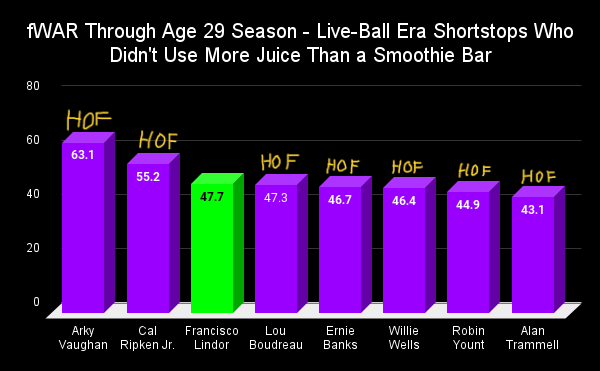 Do ya get it? Do ya understand? Lindor isn’t just a good shortstop. He’s not just a great shortstop. Francisco Lindor is playing like one of the greatest shortstops of all time through his 20s, and as he enters his 30s, he’s looking as good as ever. In the last two seasons, Mets fans have enjoyed two consecutive 6+ fWAR seasons from Lindor, showing that he’s entering his fourth decade of life as productive as ever. Folks, this is one of the greatest shortstops of all time we may be watching here, somebody whose resume you can stack up against any other shortstop in modern history. Let’s talk about him more!
Do ya get it? Do ya understand? Lindor isn’t just a good shortstop. He’s not just a great shortstop. Francisco Lindor is playing like one of the greatest shortstops of all time through his 20s, and as he enters his 30s, he’s looking as good as ever. In the last two seasons, Mets fans have enjoyed two consecutive 6+ fWAR seasons from Lindor, showing that he’s entering his fourth decade of life as productive as ever. Folks, this is one of the greatest shortstops of all time we may be watching here, somebody whose resume you can stack up against any other shortstop in modern history. Let’s talk about him more!

Great article! Thank you for the insight!
He’s still not as good as Jose Reyes.
Hear, hear! I do worry a little about whether Lindor’s insistence on playing virtually every day might have consequences for his longevity, and he has been swinging and missing more, although that’s probably more about trading swing-and-miss for power in a notoriously hitter-unfriendly ballpark than anything else. I wish the Mets had a better backup infielder than 93-year-old Joey Wendle (look it up!), because I feel like Francisco could benefit from a few more days off as he enters his 30s, but then again, maybe being out there every day helps him stay in rhythm on both sides of the ball. I also wonder whether the Mets might want to consider eating some of his contract and trading him before he starts to decline (as well as Nimmo, Alonso—whom they’re going to lose anyway, Díaz, and Senga), because they are going to be bad for the foreseeable future, given how awful their pitching is, with no help on the horizon (they might have the most overrated farm system in MLB, and it isn’t even that highly-rated). [The back half of this comment has been hijacked by the depressed pessimist who lives full-time in my brain.]
The Mets are weird. They have Nimmo, Lindor and Alonso – all of whom are elite/very good, and Alvarez, who is one of the brightest young catchers in the game. I think 2024 for the Mets is going to be a sort of retooling year, hoping for some internal development, while they gear up for 2025 when the Verlander/Scherzer contracts are over
Wow, Carson. This is a great article. I was intrigued by your in-depth analysis of Lindor. I’m looking forward to reading more of your stories.
He’s much better than Reyes.
Too bad He has ZERO LEADERSHIP or class. Thumbs down Mr. Smile hasn’t won DIDDLY. All these years of greatness & money & he still hasn’t figured out how to inspire OTHERS around Him to be better.
What team player, trying to foster team camaraderie, makes a promise (McNeil batting title car) & holds out? A LOSER, that’s who! That’s NOT team- building… & he’s never inspired WINNING — give me Seager, Jeter, etc., this crybaby comes up SMALL in big moments year-after-year. And has won: NOTHING! FACT!
As a former Brooklyn fan I tend to lean toward Reese, but must admit Lindor is and has been a very gifted fielder at his position; even Reyes, as good as he was, does not quite match the mark which Lindor stands at.
eye opening! even with the y’all thrown in, great writing!
As a lifelong Indians/Guardians fan and clearly remembering when Lindor first became a starter for the then Indians back in 2015, there is one thing I’d like to add about Frankie’s batting struggles the past few years: it all started when he started swinging for the fences. During his first 2 years he batted .313 and .301 respectively. Then, in 2017 he became focused on hitting more home runs. He hit 33 compared to 15 in 2016, but his RBI increased only by 11; from 78 to 89. The biggest change was his batting avg. dropping from .301 all the way down to .273. He hasn’t been the same since. Batting .280 or above only once during the last seven years. I’m afraid the BIG money and BRIGHT lights of the BIG Apple have gotten to Frankie. In many ways it reminds me of what happened to former Indian great, Carlos Baerga, when he ended up in NYC.
What drivel….written by another pundit who thinks data is the only way to judge a player’s effectiveness. The major problem is that you don’t watch 162 games of a player….which is the only way to provide critical context that you use in combination with data. This would show you that Lindor’s data is as hollow as a warm breeze. Multiple months of complete ineffectiveness in every season as a Met. Continuous underperformance in clutch situations….and statistical accumulation in blowouts and low-leverage situations. However you spin it…..a superstar offensive player does not have trouble reaching an .800 ops AND 30 doubles every single year. These are plateaus that Lindor has only reached once in a met uniform and just barely.
Bottom line…..Lindor is a nice SS with a great glove. He has too many holes in his offensive game to be considered a franchise player. What he was in 2018 doesn’t matter any more…..period